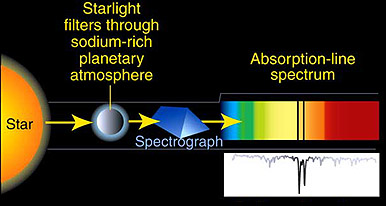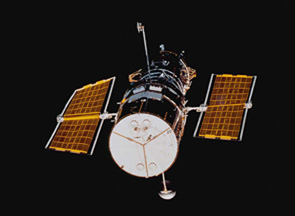Click on image for full size
Courtesy of STScI
Hubble Detects the First Extrasolar Planetary Atmosphere!
News story originally written on November 28, 2001
To date, 76 extrasolar planets are known. Yesterday, the first detection of an extrasolar planetary atmosphere was announced! As well, this is the first chemical analysis to be done on the atmosphere of a planet outside our own solar system!
HD209458b is a Jupiter-like planet that orbits around a star named HD209458. HD209458 is considered a near-by star at about 150 light years away from our solar system. HD209458b is a huge planet (0.7 times the mass of Jupiter) that orbits very, very close to its star (inside where the orbit of Mercury would be in our own solar system!). Because it is so close to its star, HD209458b has an atmosphere that is probably close to 1,000 degrees Celsius.
Seven hours of exposure time using the STIS instrument onboard the Hubble Space Telescope (HST) in April and May 2000, resulted in the detection of the atmosphere of HD209458b. The STIS instrument is the Space Telescope Imaging Spectrograph. It provides spectral signatures in the ultraviolet and visible wavelengths.
Specifically, the atmosphere was detected using the transit method and spectroscopy (see the image on this page). HD209458b takes about 3 hours to pass across the star and the light brightness we see from Earth dims for the period of the 3 hours (because the planet blocks some of the light). When HD209458b was transiting the star, the STIS looked at the light from the star as it passed through HD209458b's atmosphere. And so STIS could process a spectral signature from HD209458b's atmosphere. Spectroscopy depends on the fact that different chemical compounds have different spectral signatures. Scientists looked and found the prominent signature of sodium. Scientists only found half the amount of sodium that models predict, but they did find sodium! Scientists looked for the sodium spectral signature because it is so prominent (and because sodium’s spectral signature is in the visible region where the STIS instrument can measure).
The HST was not specifically designed for this type of measurement. In fact, the HST was launched before any extrasolar planets were known. So, it is impressive that we can look at the atmosphere of a planet that is so far away! Future space missions specifically designed for this type of measurement will no doubt discover many more exciting things about extrasolar planetary atmospheres, but HST has laid the groundwork.
In the next decade, scientists will likely want to:















